A couple days ago, I introduced you to Yuki Sugashima of Barefoot Shepherdess, who uses natural dyes to color various threads and yarns for needlework. Today, Yuki presents a few of her favorite plants that she uses to dye her threads. Enjoy!
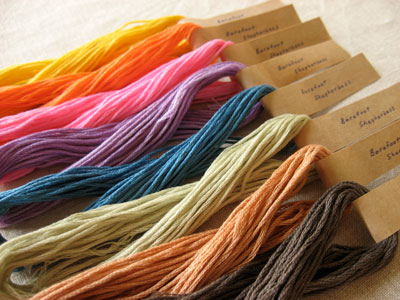
In terms of the particular natural dyes I use: while I’m constantly trying new dye sources, there is a core set of dyes that I work with regularly for my shop, ones that I’ve found tobe reliable and reasonably colorfast. These are dyes that are locally available or at least, ones that have a history of use in Japan, as to me, natural dyeing is about working from one’s surrounding environment, and I want to maintain that aspect in my own dyeing. Just as important is the safety factor– since I work in my kitchen with a curious three- year-old by my side, I’ve selected dyes and mordants that are relatively safe or even, edible. Even within these limitations, I’ve been able to achieve a full range of colors, which truly attests to the amazing array of dyestuffs nature has to offer.
So what are some of these dyes? Here’s an introduction to a few favorites.
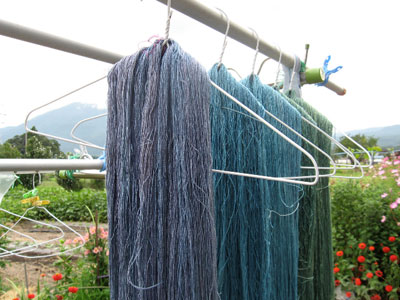
Japanese Indigo
Japanese indigo has long been the source of blue in Japan. There are multiple ways to dye with it, depending on whether the leaves or fresh or dried. My indigo was homegrown for me on my grandparents’ farm in the mountains of Nagano prefecture. I spent last summer dyeing with the fresh leaves on site using water from the irrigation canal that runs through their property and feeds the rice paddies in the area. It’s diverted from a nearby river that runs down from the mountains, so it’s truly crystal clear. Those leaves I couldn’t use right away, my grandmother and I hand picked and laid out to dry in the summer sun to preserve them for dyeing all year round. It was a labor-intensive process, but was very much worth the effort!
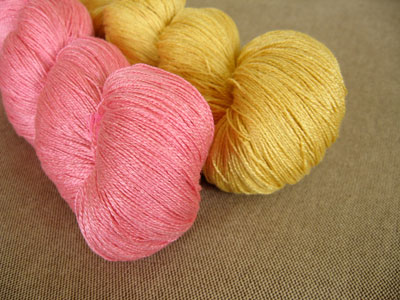
Safflower
Safflower is a unique dye source in that its delicate petals contain two dyes: a yellow and a pink. Both colors can be extracted from a single batch of petals by first removing the yellow in water, then the pink in an alkaline solution. The pink, especially, has a long history of use in Japan– the color can be dyed deeply to achieve almost a red, or it can be used in combination with indigo for a lavender/purple or with any yellow dye for an orange. Young safflower leaves are also edible as salad greens, and its seeds are the source of safflower oil for cooking.
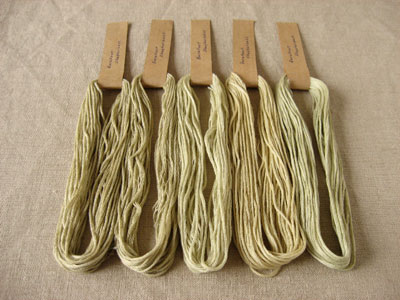
Yomogi (Japanese mugwort)
A harbinger of spring, yomogi grows along almost any roadside here from about March to October. They grow quite rapidly and vigorously too, so that combined with their ready availability and long growing season, make them an ideal local dye source for me. What I found most interesting with yomogi is the subtle, yet distinct differences in the resulting color– all shades of sage green– depending on the batch of plants I used. As I kept the amounts and methods consistent for each lot, it really goes to show how much the growing environment of the plant can affect the resulting color. Yomogi is also an edible plant. It’s best known as kusa-mochi, a yomogi-flavored rice cake often filled with sweet red bean paste.
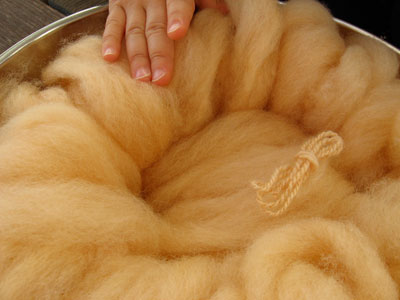
Sakura (Cherry Tree)
The fallen foliage of the sakura tree is another great local dye source as the trees are very common here. Back in autumn, my son and I went around the neighborhood parks collecting the leaves, taking care to choose only the freshly fallen ones as they are supposed to have better color than the ones already rained upon. It’s also possible to use fresh green leaves, but fallen ones are easier to gather and not stressful to the tree itself. With sakura leaves, it’s best to let the dye bath rest for a few days after extracting the dye in order to increase the redness. The resulting color is a warm peach.
These are just a few of the better-known dyes in Japan; there are many, many more. Traditional natural dyes with a long history of use can be found worldwide while other lesser known local dyes can vary from region to region. Still other plants with dye potential have yet to be tried, quietly growing along some roadside or in a field, holding onto a colorful secret.
So the next time you’re pulling those weeds in the yard, I hope you give them a second glance and perhaps wonder what color might lie within.
I hope you’ve enjoyed reading a little bit about naturally dyeing threads! Hop on over to Yuki’s blog, Barefoot Shepherdess, to see what she’s up to with her dye stuffs today! If you’re looking for naturally dyed embroidery threads, check out the Barefoot Shepherdess Etsy shop, where you’ll find some vibrant colors attached to beautiful embroidery threads! Thanks, Yuki, for your introduction to dyeing threads using the elements of nature!







G’day Mary and Yuki,
‘Holding onto a colourful secret’. Delightful Yuki. Like a book eh. You can’t judge it just by it’s cover. Nature never ceases to surprise and inspire me. Now I will be in even greater awe as I think and ‘see’ beyond the covers.
‘The skies are grey,
The rooftops are grey,
The whole city is grey’
That is from today’s Barefoot Shepherdess blog.
I’m glad grey is not just a mood but is colours within a colour and is a colour within colours.
Grey can be a range of beautiful colours.
I hope we will always be able to see, and appreciate them.
Happy travelling Mary and thank you both.
Cheers, Kath.
The colours produced by Safflower are amazing! I love the pink!
This and your earlier post have recalled my science lessons from (goodness me!) ….. it must be 30 odd years ago and how fascinating it was to carry out some dyeing.
What do you use for mordants? Or are such details trade secrets 🙂
Elaine
Cheshunt, Hertfordshire, UK
This has been very, very interesting. I appreciate your dedication to the regional and natural integrity of your art. And I WILL look at my “weeds” with different eyes!
Thank you for the totally fascinating posts on Natural Dyeing.
Absolutely gorgeous color. I live for color and this made my day!